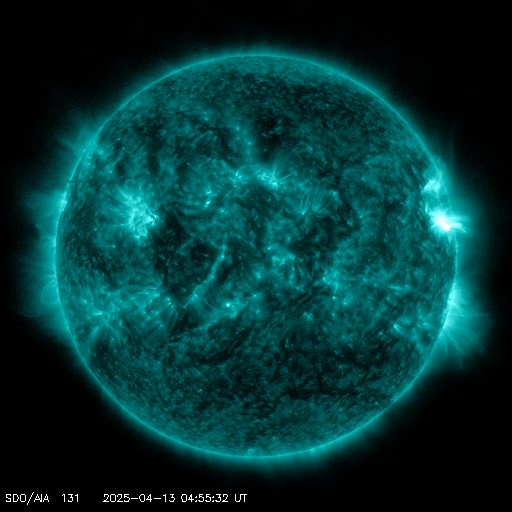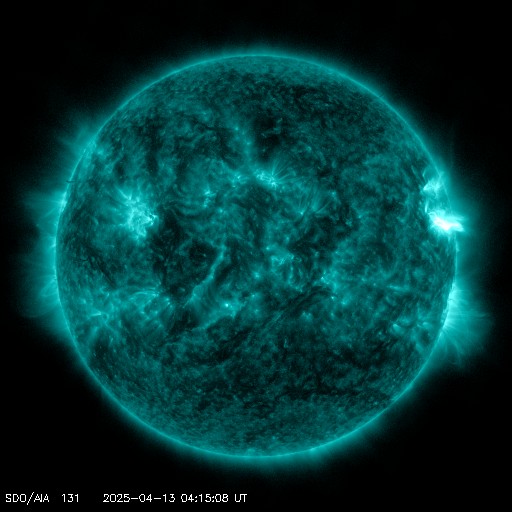Het archief bekijken van zaterdag 7 september 2024
Dagelijks bulletin over zonne- en geomagnetische activiteit van het SIDC
Datum verslag: 2024 Sep 07 1241 UTC
SIDC Prognose
Zonnevlammen
M-class flares expected (probability >=50%)
Geomagnetisme
Quiet (A<20 and K<4)
Proton Flux monitor
Quiet
| 10cm flux | Ap | |
|---|---|---|
| 07 Sep 2024 | 239 | 010 |
| 08 Sep 2024 | 239 | 015 |
| 09 Sep 2024 | 239 | 007 |
Zonnevlekkengebieden en zonnevlammen
Solar flaring activity was at moderate levels over the past 24 hours, with several C-class flares and one M-class flare. The strongest was an M1.7 flare from NOAA active region (AR) 3813, which peaked at 07:46 UTC on September 7. The most magnetically complex active regions currently on the disk are NOAA AR 3806 (beta-gamma-delta), AR 3813 (beta-gamma), and the newly emerged AR 3815 (beta-gamma). Solar flaring activity is expected to remain at moderate levels over the next 24 hours, with the possibility of an M-class flare and a chance for isolated X-class flares.
Coronale massa uitstoten
No Earth-directed coronal mass ejection (CME) was detected in LASCO/C2 coronagraph images over the past 24 hours.
Zonnewind
The solar wind parameters reflect a slow wind speed regime. The total interplanetary magnetic field (IMF) ranged between 5 nT and 8 nT, slightly increasing over the last 6 hours and reaching 10 nT. The southward IMF component (Bz) fluctuated between -7 nT and +9 nT. The solar wind speed remained around 335-430 km/s. Solar wind conditions are expected to become more enhanced in the next 24 hours due to the September 3 coronal mass ejection, combined with the high-speed stream from the small negative polarity coronal hole that crossed the central meridian on September 3.
Geomagnetisme
Geomagnetic conditions were quiet both globally and locally, with some periods of unsettled conditions (NOAA Kp and K-Dourbes indices of 1-3). Quiet to unsettled conditions are expected in the next 24 hours, with possible active periods in response to the anticipated enhancement of solar wind conditions.
Proton flux niveaus
The greater than 10 MeV GOES proton flux has now returned to background levels. It is expected to remain at background levels over the next 24 hours. However, there is a small chance of exceeding the threshold if high-energy flares or eruptions occur.
Elektronenfluxen in geostationaire baan
The greater than 2 MeV electron flux, as measured by the GOES-16 satellite, remained below the threshold over the past 24 hours and is expected to remain so in the coming 24 hours. The 24-hour electron fluence is currently at normal levels and is expected to stay that way over the next 24 hours.
Het geschatte internationale zonnevlekkengetal (ISN) van vandaag: 162, gebaseerd op 10 stations.Zon indexen voor 06 Sep 2024
| Wolfgetal Catania | 263 |
| 10cm zonneflux | 249 |
| AK Chambon La Forêt | 014 |
| AK Wingst | 007 |
| Geschatte Ap | 007 |
| Geschat internationaal zonnevlekkengetal | 188 - Gebaseerd op 17 stations |
Overzicht opvallende gebeurtenissen
| Dag | Start | Max | Einde | Locatie | Sterkte | OP | 10cm | Catania/NOAA | Soorten radio-uitbarstingen |
|---|---|---|---|---|---|---|---|---|---|
| 07 | 0617 | 0749 | 0917 | S27E34 | M1.6 | 1F | 82/3815 |
Aangeboden door het Solar Influences Data Analysis Center© - SIDC - Verwerkt door SpaceWeatherLive
Alle tijden in UTC
<< Keer terug naar de dagelijkse overview pagina
Op basis van de huidige parameters is er in de nabije toekomst een beperkte kans op poollicht op de volgende locaties van de hoge breedtegraad
Gillam, MB, Yellowknife, NTLaatste nieuws
Laatste forumberichten
Steun Poollicht.be!
Om ook bereikbaar te blijven bij grote poollichtkansen hebben we een zware server nodig die alle bezoekers aankan. Doneer en steun dit project zodat we online blijven en je geen enkele poollichtkans mist!

Laatste alerts
05:12 UTC - Zonnevlam
Matige M2.31 zonnevlam
04:54 UTC - Radio blackout
Kleine R1 radio blackout gedetecteerd (≥M1 - momenteel: M1.89)
04:48 UTC - Zonnevlam
Matige M1.12 zonnevlam
04:24 UTC - Zonnevlam
Matige M1.13 zonnevlam
04:09 UTC - Radio blackout
Kleine R1 radio blackout gedetecteerd (≥M1 - momenteel: M1.13)
Ruimteweer feitjes
| Laatste X-klasse uitbarsting | 28/03/2025 | X1.1 |
| Laatste M-klasse uitbarsting | 12/04/2025 | M1.3 |
| Laatste geomagnetische storm | 06/04/2025 | Kp5 (G1) |
| Zonnevlekkenloze dagen | |
|---|---|
| Laatste zonnevlekkenloze dag | 08/06/2022 |
| Maandelijks gemiddeld zonnevlekkengetal | |
|---|---|
| maart 2025 | 134.2 -20.4 |
| april 2025 | 136.4 +2.2 |
| Afgelopen 30 dagen | 134.7 -7.2 |





